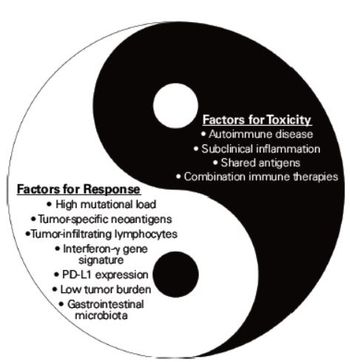
A retrospective study of ICIs by French investigators found manageable toxicity in patients over age 70, and survival outcomes comparable to younger patients.

Your AI-Trained Oncology Knowledge Connection!


A retrospective study of ICIs by French investigators found manageable toxicity in patients over age 70, and survival outcomes comparable to younger patients.

In this podcast, Dr. Debra Patt discusses trends in cancer care, including how treatments are becoming more personalized and less toxic.

In this article, we detail the experience with immune checkpoint inhibitors in patients with autoimmune disease.

Drs. Kato and Kurzrock discuss the potential reasons why some cancer patients experience hyperprogression of disease while on immunotherapy treatment.

Given disconcerting low success rates overall in immunotherapy, some leading oncologists are calling for greater scientific rigor in clinical trial design.

Dr. Stephen Baylin discusses his 2018 AACR meeting presentation on SU2C research into using epigenetic therapy to boost immune checkpoint therapy.

A phase III study by Dr. Robert Motzer and colleagues in NEJM found significantly higher OS and ORRs with the immunotherapy combination.

A significant number of patients receiving immune checkpoint inhibitor therapy have developed myocarditis, but the reasons behind it are still unclear.

Medicial oncologist and melanoma expert Dr. Jeffrey Weber discusses the role of adjuvant immunotherapy in the setting of stage III melanoma.

STING (stimulator of interferon genes) agonists have been shown to help T cells thrive and work synergistically with other cancer therapies, so new trials are underway to test whether they can be used to improve response in certain patients.

Umbralisib, a dual inhibitor of PI3Kδ and casein kinase-1Ɛ, was well tolerated and showed early signs of clinical activity in a phase I lymphoma study.

The oral therapy combination of ixazomib, pomalidomide, and dexamethasone was effective and well-tolerated in patients with myeloma that had relapsed or was refractory to lenalidomide.

CLL patients responded well to induction with the RCC regimen cladribine, cyclophosphamide, and rituximab followed by maintenance rituximab.

In a mouse model, researchers were able to prevent certain cancers using a vaccine made from induced pluripotent stem cells in combination with an immunostimulant agent.

ASCO and NCCN have released guidelines on assessment and management of immune checkpoint inhibitor–related side effects.

The significant tumor shrinkage and immunologic changes observed support a complementary role of SBRT and PD-1 immunotherapy, investigators concluded.

Early-phase data on larotrectinib validate TRK fusions as therapeutic targets and show they lead to tumor-agnostic sensitivity to this agent.

A preplanned analysis of ctDNA found that a subpopulation of mCRC patients with acquired anti-EGFR resistance were sensitive to treatment with Sym004.

Single-agent ibrutinib resulted in sustained efficacy and durable responses in treatment-naive or relapsed/refractory CLL or SLL, 5-year results show.

Investigators have discovered that clofarabine and cladribine may be used as a targeted therapy in diseases where CD99 plays a critical role, including Ewing sarcoma and auto-immune disorders.

Researchers have made a discovery linking chromosomal instability to cancer metastasis through chronic inflammation, a first in identifying a widespread genomic driver of metastasis.

ImmunoMap, which can examine T-cell receptor repertoire relatedness, may help predict clinical outcome for patients with cancer and could be a new tool for designing vaccines and immunotherapies.

The combination therapy increased the attraction of immune cells to fight non-small cell lung cancer and also boosted the response to immune checkpoint inhibitors.

MMG49 has been identified as a monoclonal antibody that can be targeted using CAR T-cell therapy for patients with multiple myeloma.

A recent study showed that molecular tumor boards coupled with cognitive computing with IBM's Watson could improve patient care by providing a rapid, comprehensive approach for data analysis.